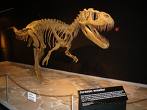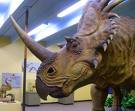Natural History Museums
Natural history museums can provide us with information about dinosaurs. There are literally hundreds of dinosaur displays worldwide. Each of these displays are the end result of tremendous amount of work and sometimes may involve a very substantial financial outlay.
The larger museums often employ an army of highly skilled designers and artists whose job is to put the exhibitions together. The process involves input from paleontologists and designers to decide on the basic theme of the display. Many of the decisions to be made include whether they are going to use mounted skeletons, full size reconstructions, robotic dinosaurs, or computer graphics or perhaps some combination of all of these.
 When
a skeleton is to be mounted for display, casts of every bone need to be
made. Fossilized bone is too heavy to mount safely in a display, and fossil
material that has been used as part of an exhibit is not readily available
for further study. Casts display a very accurate reproduction of the original
specimen, and they have the advantage that they can be touched by visitors.
When
a skeleton is to be mounted for display, casts of every bone need to be
made. Fossilized bone is too heavy to mount safely in a display, and fossil
material that has been used as part of an exhibit is not readily available
for further study. Casts display a very accurate reproduction of the original
specimen, and they have the advantage that they can be touched by visitors.
Making casts of every bone in a dinosaur specimen, as well as re-creating missing bones, can be time-consuming and it can take many months to produce. The construction of a full-size model dinosaur is often quicker and less expensive to manufacture. Either way the job is long and painstaking.
 Once
a specimen has been displayed to the public, it is sent to its final resting
place as part of the collections of the Museum. Although the displays
are the most visible part of any museum, the collections are actually
more important, they provide a safekeeping place where the fossils can
be made available to be stududied by paleontologists.
Once
a specimen has been displayed to the public, it is sent to its final resting
place as part of the collections of the Museum. Although the displays
are the most visible part of any museum, the collections are actually
more important, they provide a safekeeping place where the fossils can
be made available to be stududied by paleontologists.
Every specimen is catalogued, so that it can be located easily, and then stored in wherever way is considered most appropriate for that particular fossil. The specimens are protected by keeping them in a room at a constant temperature and humidity.
Specimens that represent new species are called "types," and this must be stored with extra care. In many cases this type of specimens will never be allowed to leave the museum.